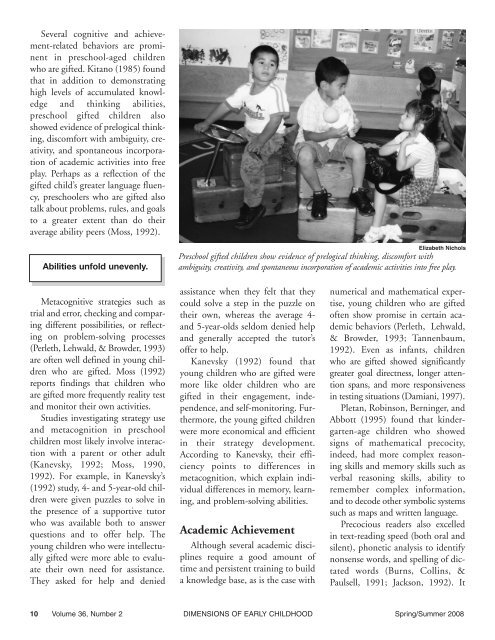Recognizing Giftedness: Defining High Ability in Young Children
Recognizing Giftedness: Defining High Ability in Young Children
Recognizing Giftedness: Defining High Ability in Young Children
You also want an ePaper? Increase the reach of your titles
YUMPU automatically turns print PDFs into web optimized ePapers that Google loves.
Several cognitive and achievement-related<br />
behaviors are prom<strong>in</strong>ent<br />
<strong>in</strong> preschool-aged children<br />
who are gifted. Kitano (1985) found<br />
that <strong>in</strong> addition to demonstrat<strong>in</strong>g<br />
high levels of accumulated knowledge<br />
and th<strong>in</strong>k<strong>in</strong>g abilities,<br />
preschool gifted children also<br />
showed evidence of prelogical th<strong>in</strong>k<strong>in</strong>g,<br />
discomfort with ambiguity, creativity,<br />
and spontaneous <strong>in</strong>corporation<br />
of academic activities <strong>in</strong>to free<br />
play. Perhaps as a reflection of the<br />
gifted child’s greater language fluency,<br />
preschoolers who are gifted also<br />
talk about problems, rules, and goals<br />
to a greater extent than do their<br />
average ability peers (Moss, 1992).<br />
Abilities unfold unevenly.<br />
Elizabeth Nichols<br />
Preschool gifted children show evidence of prelogical th<strong>in</strong>k<strong>in</strong>g, discomfort with<br />
ambiguity, creativity, and spontaneous <strong>in</strong>corporation of academic activities <strong>in</strong>to free play.<br />
Metacognitive strategies such as<br />
trial and error, check<strong>in</strong>g and compar<strong>in</strong>g<br />
different possibilities, or reflect<strong>in</strong>g<br />
on problem-solv<strong>in</strong>g processes<br />
(Perleth, Lehwald, & Browder, 1993)<br />
are often well def<strong>in</strong>ed <strong>in</strong> young children<br />
who are gifted. Moss (1992)<br />
reports f<strong>in</strong>d<strong>in</strong>gs that children who<br />
are gifted more frequently reality test<br />
and monitor their own activities.<br />
Studies <strong>in</strong>vestigat<strong>in</strong>g strategy use<br />
and metacognition <strong>in</strong> preschool<br />
children most likely <strong>in</strong>volve <strong>in</strong>teraction<br />
with a parent or other adult<br />
(Kanevsky, 1992; Moss, 1990,<br />
1992). For example, <strong>in</strong> Kanevsky’s<br />
(1992) study, 4- and 5-year-old children<br />
were given puzzles to solve <strong>in</strong><br />
the presence of a supportive tutor<br />
who was available both to answer<br />
questions and to offer help. The<br />
young children who were <strong>in</strong>tellectually<br />
gifted were more able to evaluate<br />
their own need for assistance.<br />
They asked for help and denied<br />
assistance when they felt that they<br />
could solve a step <strong>in</strong> the puzzle on<br />
their own, whereas the average 4-<br />
and 5-year-olds seldom denied help<br />
and generally accepted the tutor’s<br />
offer to help.<br />
Kanevsky (1992) found that<br />
young children who are gifted were<br />
more like older children who are<br />
gifted <strong>in</strong> their engagement, <strong>in</strong>dependence,<br />
and self-monitor<strong>in</strong>g. Furthermore,<br />
the young gifted children<br />
were more economical and efficient<br />
<strong>in</strong> their strategy development.<br />
Accord<strong>in</strong>g to Kanevsky, their efficiency<br />
po<strong>in</strong>ts to differences <strong>in</strong><br />
metacognition, which expla<strong>in</strong> <strong>in</strong>dividual<br />
differences <strong>in</strong> memory, learn<strong>in</strong>g,<br />
and problem-solv<strong>in</strong>g abilities.<br />
Academic Achievement<br />
Although several academic discipl<strong>in</strong>es<br />
require a good amount of<br />
time and persistent tra<strong>in</strong><strong>in</strong>g to build<br />
a knowledge base, as is the case with<br />
numerical and mathematical expertise,<br />
young children who are gifted<br />
often show promise <strong>in</strong> certa<strong>in</strong> academic<br />
behaviors (Perleth, Lehwald,<br />
& Browder, 1993; Tannenbaum,<br />
1992). Even as <strong>in</strong>fants, children<br />
who are gifted showed significantly<br />
greater goal directness, longer attention<br />
spans, and more responsiveness<br />
<strong>in</strong> test<strong>in</strong>g situations (Damiani, 1997).<br />
Pletan, Rob<strong>in</strong>son, Bern<strong>in</strong>ger, and<br />
Abbott (1995) found that k<strong>in</strong>dergarten-age<br />
children who showed<br />
signs of mathematical precocity,<br />
<strong>in</strong>deed, had more complex reason<strong>in</strong>g<br />
skills and memory skills such as<br />
verbal reason<strong>in</strong>g skills, ability to<br />
remember complex <strong>in</strong>formation,<br />
and to decode other symbolic systems<br />
such as maps and written language.<br />
Precocious readers also excelled<br />
<strong>in</strong> text-read<strong>in</strong>g speed (both oral and<br />
silent), phonetic analysis to identify<br />
nonsense words, and spell<strong>in</strong>g of dictated<br />
words (Burns, Coll<strong>in</strong>s, &<br />
Paulsell, 1991; Jackson, 1992). It<br />
10 Volume 36, Number 2 DIMENSIONS OF EARLY CHILDHOOD Spr<strong>in</strong>g/Summer 2008
















